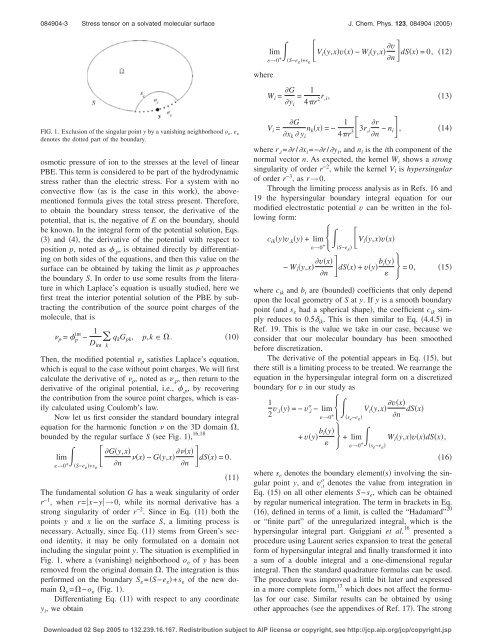Calculation of the Maxwell stress tensor and the Poisson-Boltzmann ...
Calculation of the Maxwell stress tensor and the Poisson-Boltzmann ...
Calculation of the Maxwell stress tensor and the Poisson-Boltzmann ...
Create successful ePaper yourself
Turn your PDF publications into a flip-book with our unique Google optimized e-Paper software.
084904-3 Stress <strong>tensor</strong> on a solvated molecular surface J. Chem. Phys. 123, 084904 2005limi y,xvx − W i y,x v =0, 12→0 +S−e +s VndSxwhereW i = Gy i= 14r 2r ,i,13FIG. 1. Exclusion <strong>of</strong> <strong>the</strong> singular point y by a vanishing neighborhood o . e denotes <strong>the</strong> dotted part <strong>of</strong> <strong>the</strong> boundary.osmotic pressure <strong>of</strong> ion to <strong>the</strong> <strong>stress</strong>es at <strong>the</strong> level <strong>of</strong> linearPBE. This term is considered to be part <strong>of</strong> <strong>the</strong> hydrodynamic<strong>stress</strong> ra<strong>the</strong>r than <strong>the</strong> electric <strong>stress</strong>. For a system with noconvective flow as is <strong>the</strong> case in this work, <strong>the</strong> abovementionedformula gives <strong>the</strong> total <strong>stress</strong> present. Therefore,to obtain <strong>the</strong> boundary <strong>stress</strong> <strong>tensor</strong>, <strong>the</strong> derivative <strong>of</strong> <strong>the</strong>potential, that is, <strong>the</strong> negative <strong>of</strong> E on <strong>the</strong> boundary, shouldbe known. In <strong>the</strong> integral form <strong>of</strong> <strong>the</strong> potential solution, Eqs.3 <strong>and</strong> 4, <strong>the</strong> derivative <strong>of</strong> <strong>the</strong> potential with respect toposition p, noted as ,p , is obtained directly by differentiatingon both sides <strong>of</strong> <strong>the</strong> equations, <strong>and</strong> <strong>the</strong>n this value on <strong>the</strong>surface can be obtained by taking <strong>the</strong> limit as p approaches<strong>the</strong> boundary S. In order to use some results from <strong>the</strong> literaturein which Laplace’s equation is usually studied, here wefirst treat <strong>the</strong> interior potential solution <strong>of</strong> <strong>the</strong> PBE by subtracting<strong>the</strong> contribution <strong>of</strong> <strong>the</strong> source point charges <strong>of</strong> <strong>the</strong>molecule, that is p = int p − 1D int q k G pk , p,k . 10kThen, <strong>the</strong> modified potential p satisfies Laplace’s equation,which is equal to <strong>the</strong> case without point charges. We will firstcalculate <strong>the</strong> derivative <strong>of</strong> p , noted as ,p , <strong>the</strong>n return to <strong>the</strong>derivative <strong>of</strong> <strong>the</strong> original potential, i.e., ,p , by recovering<strong>the</strong> contribution from <strong>the</strong> source point charges, which is easilycalculated using Coulomb’s law.Now let us first consider <strong>the</strong> st<strong>and</strong>ard boundary integralequation for <strong>the</strong> harmonic function on <strong>the</strong> 3D domain ,bounded by <strong>the</strong> regular surface S see Fig. 1, 16,18lim→0 +S−e +s Gy,x x − Gy,x xdSx =0.nn11The fundamental solution G has a weak singularity <strong>of</strong> orderr −1 , when r=x−y→0, while its normal derivative has astrong singularity <strong>of</strong> order r −2 . Since in Eq. 11 both <strong>the</strong>points y <strong>and</strong> x lie on <strong>the</strong> surface S, a limiting process isnecessary. Actually, since Eq. 11 stems from Green’s secondidentity, it may be only formulated on a domain notincluding <strong>the</strong> singular point y. The situation is exemplified inFig. 1, where a vanishing neighborhood o <strong>of</strong> y has beenremoved from <strong>the</strong> original domain . The integration is thusperformed on <strong>the</strong> boundary S =S−e +s <strong>of</strong> <strong>the</strong> new domain =−o Fig. 1.Differentiating Eq. 11 with respect to any coordinatey i , we obtainV i =G n k x =− 1x k y i 4r 33r r,in − n i, 14where r ,i =r/x i =−r/y i , <strong>and</strong> n i is <strong>the</strong> ith component <strong>of</strong> <strong>the</strong>normal vector n. As expected, <strong>the</strong> kernel W i shows a strongsingularity <strong>of</strong> order r −2 , while <strong>the</strong> kernel V i is hypersingular<strong>of</strong> order r −3 ,asr→0.Through <strong>the</strong> limiting process analysis as in Refs. 16 <strong>and</strong>19 <strong>the</strong> hypersingular boundary integral equation for ourmodified electrostatic potential v can be written in <strong>the</strong> followingform:c ik yv ,k y + limi y,xvx→0 +S−e V − W i y,x vxdSx + vy b iyn =0, 15where c ik <strong>and</strong> b i are bounded coefficients that only dependupon <strong>the</strong> local geometry <strong>of</strong> S at y. Ify is a smooth boundarypoint <strong>and</strong> s had a spherical shape, <strong>the</strong> coefficient c ik simplyreduces to 0.5 ik . This is <strong>the</strong>n similar to Eq. 4.4.5 inRef. 19. This is <strong>the</strong> value we take in our case, because weconsider that our molecular boundary has been smoo<strong>the</strong>dbefore discretization.The derivative <strong>of</strong> <strong>the</strong> potential appears in Eq. 15, but<strong>the</strong>re still is a limiting process to be treated. We rearrange <strong>the</strong>equation in <strong>the</strong> hypersingular integral form on a discretizedboundary for v in our study as12 v ,iy =−v o ,i − lim V i y,x vx→0 +s e −e n dSx+ vy b iy + lim W i y,xvxdSx,→0 +s e −e 16where s e denotes <strong>the</strong> boundary elements involving <strong>the</strong> singularpoint y, <strong>and</strong> v o ,i denotes <strong>the</strong> value from integration inEq. 15 on all o<strong>the</strong>r elements S−s e , which can be obtainedby regular numerical integration. The term in brackets in Eq.16, defined in terms <strong>of</strong> a limit, is called <strong>the</strong> “Hadamard” 20or “finite part” <strong>of</strong> <strong>the</strong> unregularized integral, which is <strong>the</strong>hypersingular integral part. Guiggiani et al. 16 presented aprocedure using Laurent series expansion to treat <strong>the</strong> generalform <strong>of</strong> hypersingular integral <strong>and</strong> finally transformed it intoa sum <strong>of</strong> a double integral <strong>and</strong> a one-dimensional regularintegral. Then <strong>the</strong> st<strong>and</strong>ard quadrature formulas can be used.The procedure was improved a little bit later <strong>and</strong> expressedin a more complete form, 17 which does not affect <strong>the</strong> formulasfor our case. Similar results can be obtained by usingo<strong>the</strong>r approaches see <strong>the</strong> appendixes <strong>of</strong> Ref. 17. The strongDownloaded 02 Sep 2005 to 132.239.16.167. Redistribution subject to AIP license or copyright, see http://jcp.aip.org/jcp/copyright.jsp


